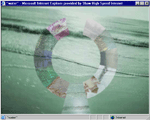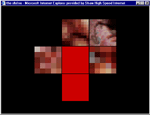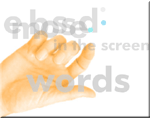| ||||||
| ||||||
| Reiner Strasser | ||
|
Reiner Strasser is known for his work as both a web.artist and an organizer/curator of web.art projects. Since 1996, Strasser has created a large and significant body of web.art, often in collaboration with other artists. The primary site for Reiner's work is netartefact.de. The work is varied technologically from masterful Javascript through Quicktime and Flash work. In it, we see a recurring concern with connecting web.art with nature and the natural. This is an ambitious project with generosity of spirit, and no mean feat, given the artificiality/virtuality of the Web. Compare the concern with nature in Strasser's work with Stanza's approach, for instance. Stanza's work focusses on the urban, thematically, and the look of the work is highly digital. The 'natural' seems somewhat out of place in the digital, often, but Strasser's work has dealt with this issue better than most. We also see in Strasser's work a synthesis of the literary, the photographic, video, and the interactive. Additionally, we see many fruitful collaborative works with other Web.artists around the world. This aspect of global collaboration and working together is surely a strong element of web.art itself, and is well-realized in Strasser's work. He curated the Weak Blood project, which involved work from many different countries. It was a protest against the bombings by NATO in Kosovo and Serbia in 1999. Weak Blood was written about in The New York Times and some of the work was shown at the Metropolitan Art Museum in Tokyo. But primarily, it was an international web.art project. He also curated the more recent Project Hope. Strasser's work is particularly well-known and regarded by the visual poets of the Web, and it is indeed highly poetical work, fluid, articulate, visually striking, and lyrically meditative in ways specific to a new art. And the choices and decisions he offers those who experience his work draw the wreader into a thinking through his carefully realized art. Reiner Strasser lives in Wiesbaden, Germany.
|
||
| Interview | ||
|
Andrews
|
What drew you initially to producing art for the Web? When did you start? | |
|
Strasser
|
I have been working with the computer since 1987. The kind of network at that time was of less interest for me. In 1996 a colleague at school (an english teacher) told me: "Look at the web. It can not be compared with what was before." I had a look. My "bottleneck" is that I can not stay on the medium without becoming creative. I began building a site (the art watchers - a biligual site for art and art&education). After meeting other artists on the Net (like i.e. Ted Warnell, Valery Grancher, and Tina LaPorta in 1997) I began to build my "pure" art site "Re:" (in english), which is still running. | |
|
Andrews
|
What draws you to it now? | |
|
Strasser
|
The "first" years have been very intriguing. It was very inspiring to meet all these artists (like you) from all over the world on the Net, to explore (the limits of) collaboration, to take part in building a "new language". The question "What draws you to it now?" I am asking myself continuously - I have asked myself in the years gone and am still asking nowadays. I like the new medium (with its advantages and limits) and feel good working on it. It is the first time I have had the chance to combine media like writing, "painting", photography and film; to produce and publish at the same time (by myself); to contact and communicate on a global level. | |
|
Andrews
|
Is what drew you initially different from what draws you to it now? | |
|
Strasser
|
Yes and No. It is less "new" - with all the "naive" fascination for a new medium. But there is still space to be explored or elaborated. | |
|
Andrews
|
What are you trying to accomplish as a web.artist? | |
|
Strasser
|
I think this question can not be answered without asking about "the identification as an artist" and "the role of an artist (in our society)". As an artist working on the Net, I think, I can work in the medium in a way that satisfies me, to fulfill my personal creative needs. On a more global level, the artist may be able to reach a wider (new) audience by "leaving the tower of ebony" or by "staying in it". | |
|
Andrews
|
What media and arts do you see your work in relation to? | |
|
Strasser
|
Media - "drawing/painting", photography, film. Arts: All and none. I am working with (on the ground of) my knowledge of art history and aesthetics and my experience in different media. | |
|
Andrews
|
What tools do you use? | |
|
Strasser
|
Pencil, computer ........., and different programs (from a text editor, picture editors, ........ to Flash). | |
|
Andrews
|
Do you consider yourself a competant programmer? Is that important to you? | |
|
Strasser
|
I use(d) html, dhtml, javascript, flash - action script. I am always looking for "scripts", when I need them for a piece. When I can not handle it (inside my own limits), I would miss it. | |
|
Andrews
|
What should a web.artist know? Apart from themselves and others. I am asking you how you see the role of technical knowledge in web.art. Is it necessary? What is necessary? | |
|
Strasser
|
As much as possible about art, as much as s/he needs to express her/himself and her/his ideas, as much as possible about her/himself. When you can not hold a brush, you can not paint. | |



